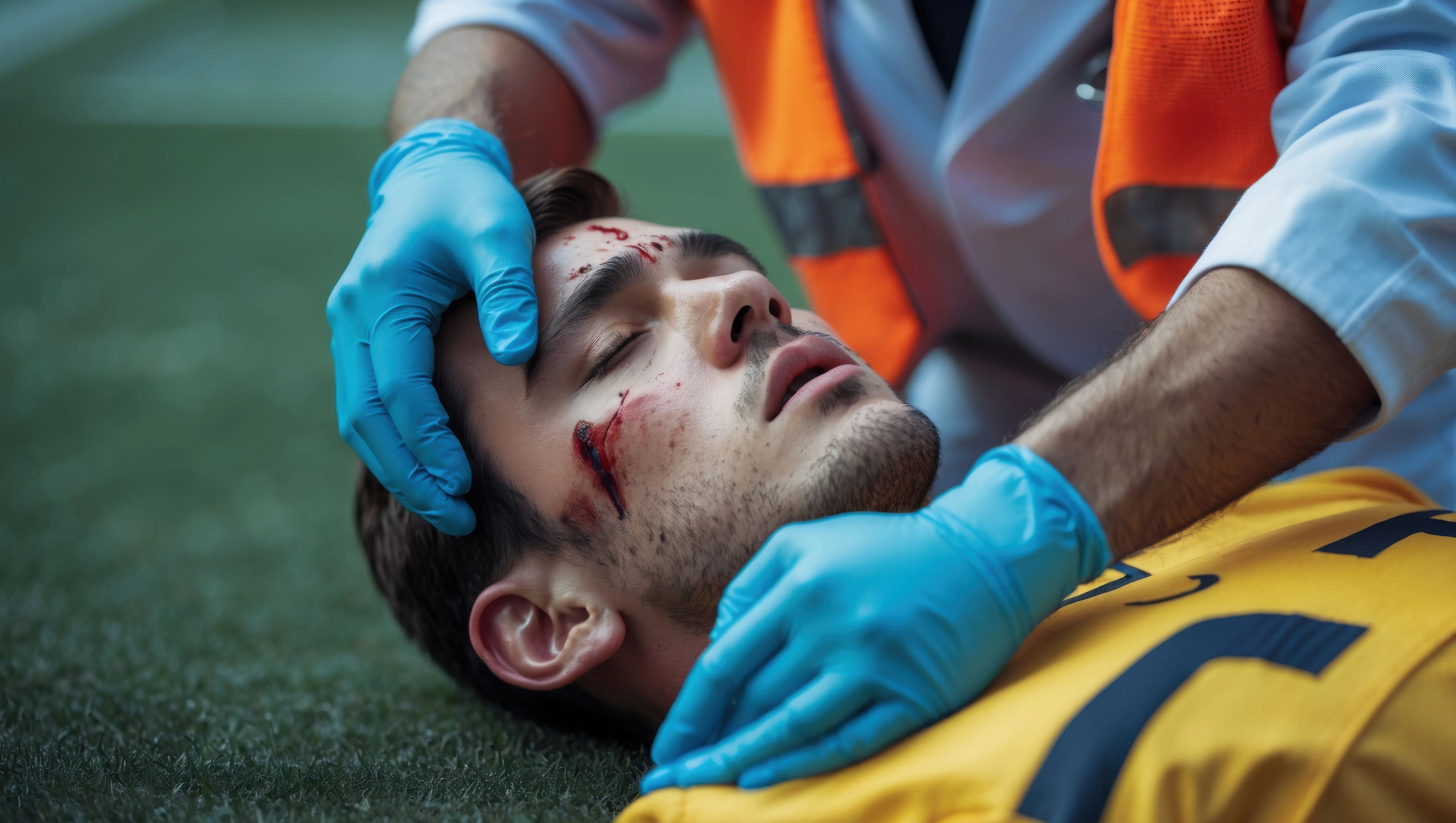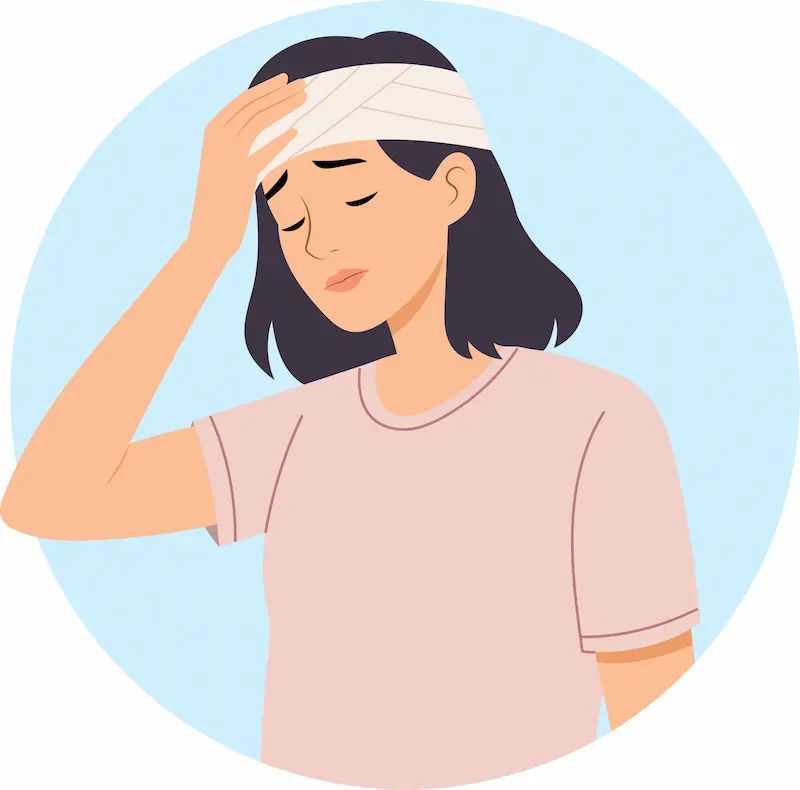Head Injury: Signs, Causes, and Prevention
Learn about head injuries, including common signs, causes, and effective prevention strategies to protect yourself and respond promptly to trauma.

Written by Dr. Dhankecha Mayank Dineshbhai
Reviewed by Dr. Rohinipriyanka Pondugula MBBS
Last updated on 17th Sep, 2025

Introduction
A sudden jolt, a slip in the bathroom, a fall from a bike: a head injury can happen in an instant, often when we least expect it. These injuries range from a minor bump on the head to a more serious traumatic brain injury (TBI), making it crucial for everyone to understand the risks. Recognising the signs of a head injury is the first step toward getting timely and appropriate care, which can significantly impact recovery. This article will guide you through everything you need to know: from identifying the subtle and obvious symptoms and understanding the common causes to implementing effective prevention strategies for you and your loved ones. Your brain is your most valuable asset; learning how to protect it is essential knowledge for modern living.
What Exactly is a Head Injury?
A head injury is any form of trauma to the scalp, skull, or brain. It can be classified as either closed (where the skull is not broken) or open (where the skull is fractured and the brain is exposed). The most common type of head injury is a concussion, which is a mild traumatic brain injury that temporarily affects brain function.
The Spectrum of Injury: From Concussion to TBI
Head injuries exist on a wide spectrum. On the milder end, a concussion may cause brief confusion or headache. More severe traumatic brain injuries can involve bruising of the brain tissue (contusion), tearing of nerve fibres (diffuse axonal injury), or bleeding in or around the brain (haematoma). These severe injuries can lead to long-term complications or even be life-threatening, underscoring the need for proper medical evaluation.
Why Immediate Attention is Non-Negotiable
The brain is soft and suspended in cerebrospinal fluid, but a violent blow can cause it to slam against the hard interior of the skull. This can cause swelling, which is dangerous because the skull cannot expand to accommodate it. Increased pressure can damage delicate brain structures. Symptoms can also be delayed, appearing hours or even days after the initial impact. Therefore, seeking a professional opinion is critical, even if the injury seems minor at first.
Consult a Neurosurgeon for the best advice
Recognising the Signs: Symptoms of a Head Injury
Symptoms can vary dramatically depending on the severity of the head injury. They may appear immediately or develop slowly over time.
Physical Symptoms to Watch For
Loss of consciousness (even briefly)
Persistent headache or a headache that worsens
Nausea or vomiting
Convulsions or seizures
Dizziness, loss of balance, or coordination problems
Drainage of clear fluid or blood from the nose or ears
Pupil dilation or uneven pupil size
Cognitive and Sensory Changes
Confusion or feeling "foggy"
Slurred speech
Memory loss surrounding the traumatic event
Sensitivity to light or sound
Blurred vision or ringing in the ears (tinnitus)
Emotional and Sleep-Related Symptoms
Irritability, agitation, or other personality changes
Depression or anxiety
Fatigue or drowsiness
Sleeping more or less than usual
Difficulty falling asleep
Symptoms in Children: A Special Note
Infants and young children cannot describe their symptoms. Look for non-verbal cues like:
Persistent crying and inability to be consoled
Changes in eating or nursing habits
Unusual irritability
Loss of interest in favorite toys or activities
Changes in sleep patterns, balance, or attention span.
Common Causes: What Leads to Most Head Injuries
Understanding the common causes is the foundation of effective prevention.
Falls: The Leading Cause for All Ages
Falls are the number one cause of head injuries, particularly for young children and older adults. This includes falls from beds, ladders, down stairs, in bathtubs, and simply slipping on uneven surfaces.
Motor Vehicle Accidents and Collisions
Collisions involving cars, motorcycles, bicycles, and pedestrians are a major cause of traumatic brain injury. The violent shaking or direct impact of the head can cause severe damage.
Sports-Related Injuries and Concussions
High-impact or contact sports like football, boxing, hockey, soccer, and basketball carry a significant risk. Even non-contact sports can lead to injuries from falls or collisions with equipment or the ground.
Violence and Assault
Unfortunately, physical assaults, including domestic violence and shaken baby syndrome, are a prevalent cause of serious head injuries.
Your First Response: What to Do If a Head Injury Occurs
Knowing how to respond quickly after a head injury can prevent complications and ensure proper care.
1. Assess the Situation: Check for responsiveness, severe bleeding, or signs of a serious injury (e.g., neck pain, seizure).
2. Stop Any Bleeding: Apply firm pressure to a wound with a clean cloth, but avoid direct pressure if you suspect a skull fracture.
3. Do Not Move the Person: Unless absolutely necessary for their safety, avoid moving them, especially if they complain of neck pain.
4. Seek Immediate Medical Help: Call for emergency services if the person is unconscious, has a seizure, or shows severe symptoms.
5. Monitor Closely: For milder injuries, monitor the person closely for the next 24-48 hours for any worsening symptoms.
Proactive Protection: How to Prevent Head Injuries
Most head injuries are preventable by making simple, smart choices.
Buckle Up! Vehicle Safety as Your First Defense
Always wear a seatbelt in a car. Ensure children are in age- and size-appropriate car seats or booster seats, correctly installed in the back seat.
The Right Helmet for the Right Activity
This is the single most effective prevention strategy for many activities. Wear a properly fitted helmet for:
Cycling, skateboarding, and scootering
Playing contact sports like football, hockey, and baseball
Riding motorcycles, snowmobiles, or ATVs
Horseback riding
Skiing and snowboarding
Making Your Home Fall-Proof
Use safety gates at the top and bottom of stairs for young children.
Install window guards.
Use non-slip mats in bathtubs and on shower floors.
Improve lighting throughout the home, especially on stairways.
Remove tripping hazards like clutter, loose rugs, and electrical cords from walkways.
Install handrails on both sides of stairways.
Safe Play and Sportsmanship
Ensure playgrounds have shock-absorbing surfaces like mulch or sand.
Supervise young children at all times.
Encourage rules of safe play and enforce the use of protective gear in sports.
Advocate for and support concussion protocols in school sports programs.
Conclusion
A head injury is a serious event that demands respect and prompt action. By understanding the wide array of symptoms, from a persistent headache to emotional changes, you empower yourself to seek help early. More importantly, by embracing preventive strategies like consistently wearing the right protective gear and making your living spaces safer, you can dramatically reduce the risk for yourself and your family. Safety is a habit. Making helmets, seatbelts, and clutter-free floors a non-negotiable part of your daily life is the best way to protect your brain's health and ensure a lifetime of wellness. Stay aware, stay safe, and never hesitate to seek professional medical guidance.
Consult a Neurosurgeon for the best advice
Consult a Neurosurgeon for the best advice

Dr. Gopal Achari
Neurosurgeon
20 Years • MBBS, MS (GEN SUR), MCH (NEURO SUR)
Kolkata
Apollo Multispeciality Hospitals , Kolkata, Kolkata

Dr. Jaidev S
Neurosurgeon
10 Years • MBBS, MS ( Genera Surgery), MCH Neurolosurgery
Bengaluru
Apollo Clinic, Indiranagar, Bengaluru

Dr Debnath Dwaipayan
Neurosurgeon
9 Years • MBBS, MS(Gen. Surgery), DrNB (Neurosurgery)
Delhi
Apollo Hospitals Indraprastha, Delhi

Dr. Aditendraditya Singh Bhati
Neurosurgeon
21 Years • MBBS(2004), DNB Neurosurgery(2014); MNAMS; Fellow Skull Base Endoscopy (Italy), Fellow Extended Skull Base ( Weill Cornell, USA), Fellow ZAP-X Radiosurgery. Member of American Association of Neurological Surgeons
Delhi
Apollo Hospitals Indraprastha, Delhi
(100+ Patients)

Dr. Bharat Subramanya
Neurosurgeon
8 Years • MBBS, DrNB Neurosurg (D6Y,NBEMS), Fellowship Park Clinic Kolkata
Bengaluru
Apollo Clinic, JP nagar, Bengaluru
More articles from Head Injury
Frequently Asked Questions
1. How long after a head injury can symptoms appear?
Concussion symptoms typically appear within minutes to hours of the injury. However, some symptoms, especially those related to cognitive function or mood, can be delayed for days or even weeks. This is why monitoring is so important.
2. Is it safe to let someone with a concussion sleep?
Historically, people were advised to keep someone awake after a concussion. Modern medical guidance states that it is safe to sleep, as rest is crucial for recovery. However, a doctor may recommend waking the person periodically for the first 12-24 hours to check for worsening symptoms like confusion or inability to wake easily.
3. What is the difference between a concussion and a traumatic brain injury?
A concussion is a type of traumatic brain injury; specifically, it is considered a mild TBI (mTBI). All concussions are TBIs, but not all TBIs are concussions. More severe TBIs involve longer periods of unconsciousness or amnesia and can include structural damage to the brain.
4. Can you fully recover from a traumatic brain injury?
Recovery depends on the severity of the injury. Many people with mild TBIs (concussions) recover fully within weeks to months with proper rest and care. Recovery from a moderate or severe TBI can be a longer process and may involve rehabilitation therapy. Some individuals may experience long-term or permanent changes.
5. What are the best fall prevention tips for the elderly?
Key tips include: removing tripping hazards (throw rugs, clutter), installing grab bars in bathrooms and railings on both sides of stairs, ensuring the home is well-lit, getting regular vision check-ups, and reviewing medications with a doctor to identify any that may cause dizziness.

